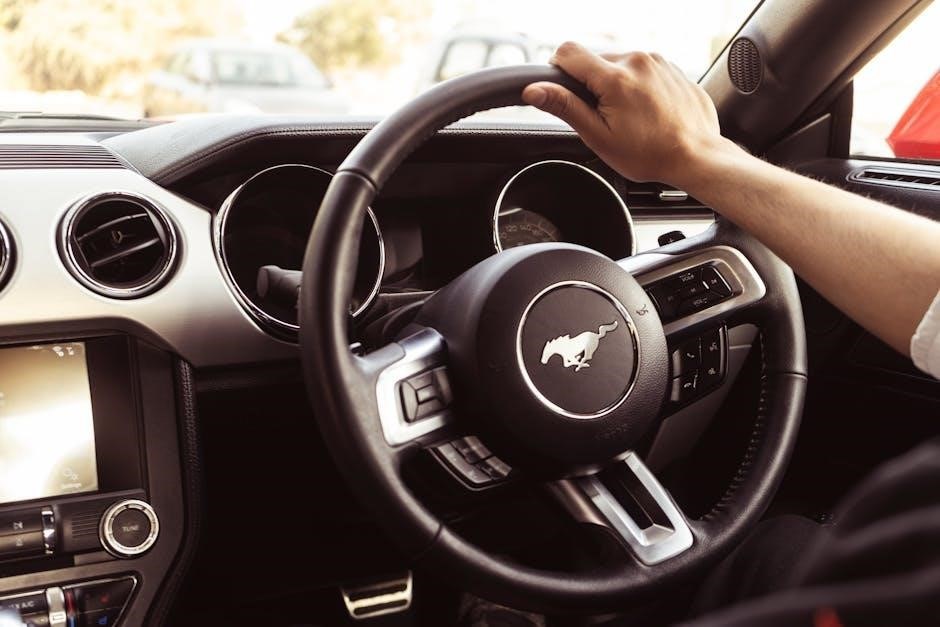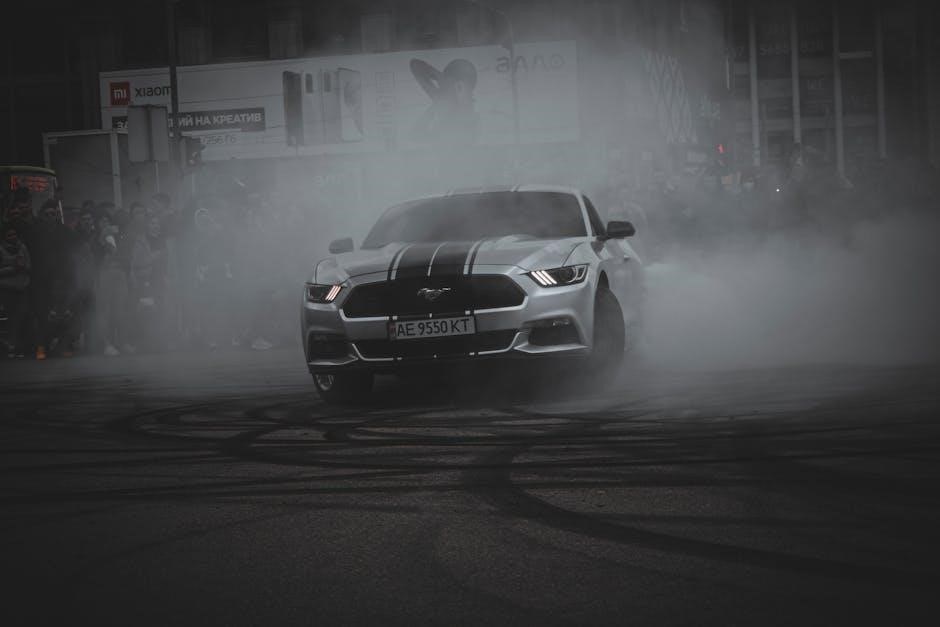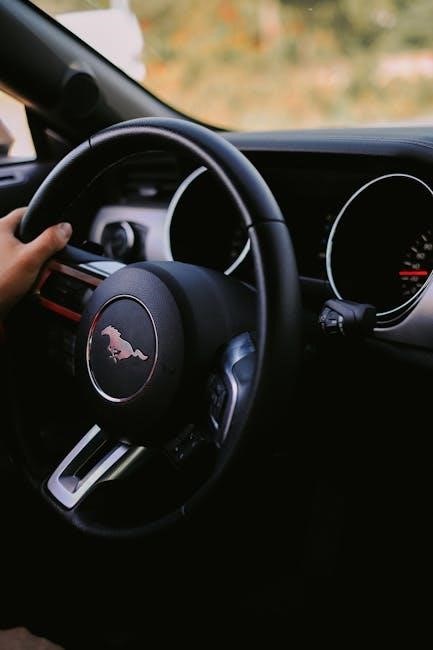
-
By:
- jayson
- No comment
how to do a burnout in a manual mustang
Enable Line Lock to lock front brakes‚ then rev the engine in first gear with clutch disengaged. Dump the clutch and balance brake and throttle for control.
A burnout in a manual Mustang involves spinning the rear tires while stationary‚ creating smoke and excitement. Line Lock is essential‚ locking front brakes to allow rear wheels to spin freely. Disabling traction control is necessary to prevent intervention. First gear is ideal for maximum torque. Rev the engine to around 2000-3000 RPM before dumping the clutch quickly. Balancing brake and throttle modulation maintains control. Safety is crucial; choose an open‚ obstacle-free area. Aftermarket mods like superchargers can enhance performance. Practice carefully to master the technique without damaging the vehicle.
Key Features of a Manual Mustang for Burnouts
A manual Mustang’s clutch system allows precise control for initiating burnouts. The availability of Line Lock enables front brake engagement‚ freeing rear wheels to spin. Rear-wheel drive delivers power directly to the tires‚ enhancing burnout potential. A powerful V8 engine provides ample torque for smoke generation. Traction and stability control systems‚ when disabled‚ prevent interference. Short gearing in first gear maximizes torque delivery‚ making it ideal for burnouts. Aftermarket modifications‚ such as superchargers‚ boost power output. Proper tire selection ensures better grip and smoke production. These features combine to make manual Mustangs well-suited for executing controlled burnouts‚ emphasizing the importance of driver skill and setup.
Preparation for a Burnout
Preparation involves checking the environment‚ disabling traction and stability control‚ selecting proper gear‚ revving the engine‚ ensuring the area is clear‚ and completing safety checks for a controlled burnout.
Understanding Line Lock and Its Role in Burnouts
Line Lock is a feature that locks the front brakes‚ allowing the rear wheels to spin freely for burnouts. Found in newer Mustangs‚ it’s activated via a button or settings. With Line Lock engaged‚ the front brakes hold the car stationary while the rear wheels spin‚ enabling a controlled burnout. This feature is especially useful in manual Mustangs‚ as it simplifies the process by eliminating the need to constantly press the brake pedal. Proper activation ensures the car remains in place‚ preventing forward movement during the burnout. This technology enhances safety and control‚ making it easier to perform burnouts effectively. Always use Line Lock in a safe‚ open environment to avoid accidents or damage to the vehicle.
Disabling Traction and Stability Control
Disabling traction and stability control is crucial for performing a burnout in a manual Mustang. These systems limit wheel spin and intervene when they detect loss of traction‚ which can hinder the burnout process. To deactivate them‚ locate the traction control button‚ typically found on the dashboard or steering wheel. Press and hold it until the system light illuminates on the dashboard‚ indicating it’s off. Some models may require navigating through the settings menu to disable these features. Once disabled‚ the rear wheels can spin freely‚ allowing the burnout to occur; Ensure the car is in a controlled environment and follow all safety protocols when performing this maneuver. Properly disabling these systems ensures uninterrupted power delivery to the wheels‚ making the burnout more effective and easier to execute. Remember to reactivate these systems after completing the burnout for normal driving safety.
Choosing the Right Gear and RPM for a Burnout
Choosing the right gear and RPM is essential for a successful burnout in a manual Mustang. Start by shifting into first gear‚ as it provides the most torque and control for initiating a burnout. Rev the engine to a moderate RPM‚ typically between 1‚500 to 2‚000 RPM for naturally aspirated engines‚ or slightly higher for supercharged models. Avoid excessive RPM‚ as it can lead to uncontrollable wheel spin. Once the engine is revved‚ dump the clutch smoothly while maintaining consistent throttle input. This balance helps maintain traction in the rear wheels while allowing them to spin for the burnout. Properly selecting the gear and RPM ensures the burnout starts effectively and remains manageable. Always ensure the car is stationary and in a safe environment before attempting this maneuver.

Step-by-Step Process for a Burnout
Enable Line Lock‚ shift into first gear‚ and rev the engine. Dump the clutch‚ apply brakes with your left foot‚ and modulate throttle for controlled wheel spin.
Revving the Engine and Preparing to Dump the Clutch
With Line Lock activated‚ shift into first gear and fully depress the clutch. Press the accelerator pedal gradually‚ increasing RPM to around 2‚000-3‚000. Feel the engine’s power build as the rear wheels remain free. Keep your left foot steady on the clutch‚ ready to release it smoothly. Ensure the car is stationary and the environment is safe. Avoid sudden movements‚ as this can cause loss of control. As you prepare to dump the clutch‚ maintain steady throttle input to balance wheel spin and forward motion. This step is critical for initiating a controlled burnout.
Dumping the Clutch and Initiating the Burnout
Quickly release the clutch pedal while maintaining steady throttle pressure. The rear wheels will spin‚ producing smoke as the tires lose traction. Keep the car stationary by balancing brake and accelerator inputs. Avoid sudden movements to prevent the car from lurching forward uncontrollably. If the car starts to move‚ gently apply the brake to stabilize it. The key is to modulate the throttle and brake simultaneously‚ ensuring the burnout remains consistent and controlled. Proper clutch release and pedal coordination are essential for a smooth initiation. This step requires focus and practice to achieve the desired effect without damaging the vehicle or losing control.
Modulating Brake and Throttle for Control
Once the burnout begins‚ carefully balance the brake and throttle pedals to maintain control. Gently press the brake with your left foot to prevent the car from moving forward while simultaneously applying light to moderate throttle with your right foot to sustain wheel spin. Adjust the throttle pressure based on the desired smoke intensity. If the wheels stop spinning‚ ease off the brake slightly. If the car starts to creep forward‚ increase brake pressure without stomping‚ which could halt the burnout abruptly. This delicate balance requires finesse and practice to keep the burnout consistent and controlled. Proper modulation ensures a smooth‚ evenly smoked rear tire without losing the desired effect or causing the car to lurch.

Safety and Best Practices
Always perform burnouts in a safe‚ open area away from traffic. Wear safety gear and ensure no bystanders are nearby. Follow local laws and regulations strictly.
Ensuring a Safe Environment for a Burnout
A safe environment is critical for performing a burnout. Choose a large‚ open space like an empty parking lot or a designated burnout area‚ ensuring no obstacles or bystanders are nearby. Avoid residential areas or public roads to prevent legal issues and potential accidents. Check for any overhead obstacles‚ such as power lines or low-hanging branches‚ that could interfere with the vehicle. Ensure the surface is flat‚ dry‚ and free of debris to maintain control. Always wear safety gear‚ including a helmet and seatbelt‚ and make sure no one is standing near or behind the car. Be aware of local laws and regulations regarding burnouts‚ as they may be prohibited in certain areas. Finally‚ inspect your Mustang to ensure all systems‚ including brakes and tires‚ are functioning properly before initiating the burnout.
Common Mistakes to Avoid During a Burnout
One common mistake during a burnout is releasing the clutch too quickly‚ which can cause the car to lurch forward uncontrollably. Another error is not modulating the throttle and brake properly‚ leading to loss of traction or premature stop. Over-revving the engine before dumping the clutch can strain the drivetrain‚ potentially causing damage. Failing to disable traction and stability control systems may prevent the wheels from spinning freely. Additionally‚ neglecting to ensure a clear‚ safe environment increases the risk of accidents or damage. Applying too much brake pressure mid-burnout can halt the process abruptly‚ while insufficient brake pressure may cause the car to move unintentionally. Finally‚ ignoring proper gear selection and RPM range can result in a weak or ineffective burnout. Avoiding these mistakes ensures a safer and more successful burnout experience in your manual Mustang.

Advanced Techniques and Modifications
Aftermarket modifications like superchargers and sticky tires enhance burnout performance. Upgraded drivetrain components ensure durability under stress. Mastering burnouts in wet or dry conditions requires precise control and practice.
Using Aftermarket Modifications for Better Burnouts

Aftermarket modifications can significantly enhance your Mustang’s burnout performance. A supercharger or nitrous oxide system increases engine power‚ allowing for more intense and longer-lasting burnouts. Upgrading to high-performance tires with softer compounds provides better traction control‚ enabling the rear wheels to spin more effectively. Additionally‚ installing an aftermarket exhaust system improves exhaust flow‚ which can increase horsepower and create a more dramatic sound during a burnout. suspension modifications‚ such as coilovers or springs‚ can lower the car and improve stability‚ making it easier to control during aggressive maneuvers. Finally‚ a limited-slip differential ensures that power is distributed evenly to both rear wheels‚ preventing uneven tire wear and enhancing the overall burnout experience. These modifications not only make burnouts more impressive but also ensure the car can handle the stress of repeated high-RPM engagements.
Mastering Burnouts in Different Driving Conditions
Mastering burnouts in various driving conditions requires adaptability and precision. On wet surfaces‚ reduce power delivery to avoid excessive wheel spin‚ which can lead to loss of control. In dry conditions‚ higher RPMs and faster clutch engagement yield more dramatic results. When performing a burnout on a slippery surface‚ such as snow or ice‚ feather the throttle gently to maintain traction while still generating smoke. For high-temperature environments‚ ensure proper tire pressure and avoid overheating the brakes by modulating them carefully. Practice in controlled environments‚ such as empty parking lots‚ to refine your technique without risking damage or safety hazards. Adjusting your approach based on weather and surface conditions will help you achieve consistent and impressive burnouts in any scenario.